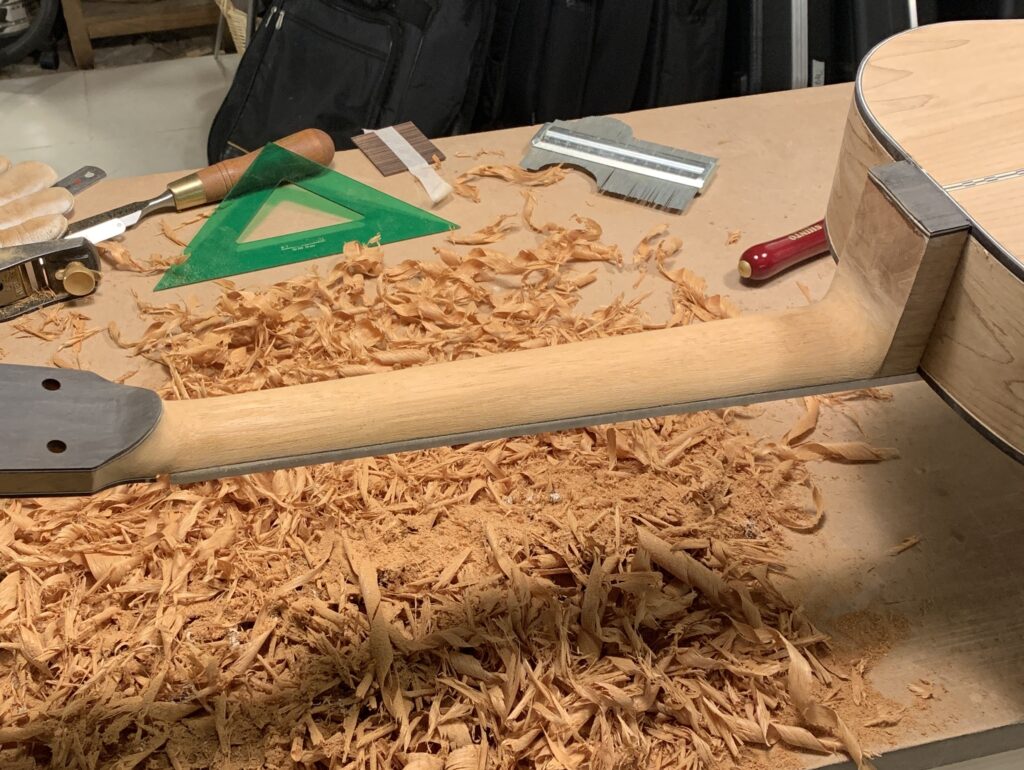If there is a part of the guitar that is tremendously personal and expresses more the idiosyncrasy of the guitarist, that is the neck. No wonder, it is the most intense and delicate point of contact between the hands and the wood. Its comfort and the softness of its touch will determine the type of bond formed between the musician and his instrument. Together with the sound quality, it is the essential part by which we will know if a guitar fits us or not. In fact, it is as simple as a neck that fits our way of playing will make us want to play more and enjoy it more.
For all this, for us at URDIAIN Guitars, the moment of sanding the neck is one of the most special, in which we try to put all our skill to meet the expectations of the musician. All this without forgetting to propose and experiment with different adjustments when the project allows us to do so.


We will now talk about the main points that we take into account in the construction of the neck: the profile, the width of the nut and the types of wood.
The profile:
Generally speaking, the profile of the necks is classified into U type, the chubbiest known as baseball bat among friends, C and D types, flatter in the part that touches the palm of the hand or thumb, and then there are the asymmetrical ones, in which the curvature draws a sort of ellipsis that makes us feel the center a little displaced. Profiles are like colors, everyone has their favorite and there is no one better than another. Although we can work with any type of profile according to the client’s preferences, due to our experience in construction we tend to use the D type profile and within this we play with its thickness, another fundamental aspect to take into account. To determine the thickness, we think it is essential to deal with the musician and know his preferences. Depending on whether it is a guitarist closer to the classical technique, or more akin to the electric guitar or exclusively an acoustic guitarist, we adjust the thickness so that he/she can still find the comfort and ergonomics that will make the instrument respond in the best possible way.






La anchura de la cejuela:
Actualmente nos estamos moviendo entre 44 y 45 cm. Tanto si es para tocar con los dedos, tipo fingerpicking, como con púa, este ancho de cejuela nos aporta una separación entre las cuerdas que hará que los dedos tengan el espacio necesario para moverse por el mástil con precisión.


The type of wood:
For the neck, our personal bet as we have already commented in other posts, is cedar. Although mahogany is the most used wood in the world of acoustic guitars for the neck, cedar joins us with the Spanish tradition of construction. In the workshop we like it very much because we find it very grateful when working with it and, of course, for its sonorous qualities, in which we find many sonorous nuances, such as the quality of the sustain and its particular brightness.
As for the fingerboard, ebony is the wood that right now is giving us the best results in combination with cedar. The transmission of energy that it allows to the top of the guitar enhances the quality of the treble and the clarity of the attack, making the final sound enjoy the right brightness to know that we are dealing with a special instrument.


In our construction process, which is both creative and evolving, these are the woods we use most often at the moment, although we also work with other woods, such as mahogany for the neck or rosewood for the fingerboard, which also give excellent results. We would love to hear your suggestions on this matter.

